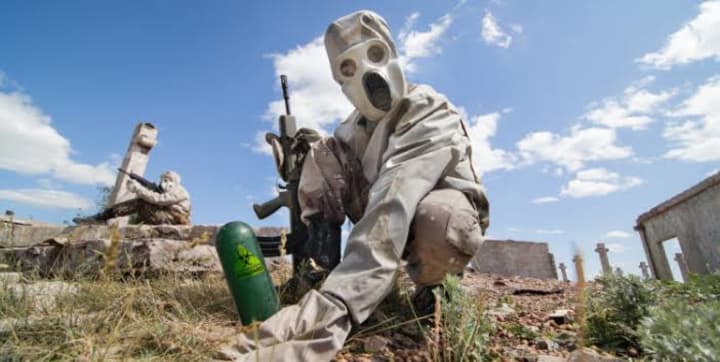The Top 10 Most Dangerous Inventions in History: Understanding the Risks and Ways to Avoid Them
The Evolution of Technology and its Impact on Humanity: Exploring the Risks and Mitigating Measures for the Most Hazardous

1. Nuclear weapons:

In 1945, the United States detonated the first atomic bomb, ushering in the nuclear age. Since then, several countries have developed nuclear weapons, creating a constant threat of global catastrophe. The use of nuclear weapons could result in the deaths of millions of people and cause untold environmental damage.
2. Biological weapons:

Biological weapons use infectious agents such as bacteria or viruses to cause illness or death. These weapons have been used throughout history, from the use of smallpox-infected blankets in the 18th century to the development of anthrax and other biological agents during World War II. Biological weapons are particularly dangerous because they can be easily spread and can have a wide range of effects, from a localized outbreak to a global pandemic.
3. Chemical weapons:

Like biological weapons, chemical weapons are designed to cause harm to people or the environment. Chemical weapons use toxic chemicals such as chlorine gas, nerve agents, or mustard gas to cause injury or death. Chemical weapons have been used in wars throughout history, from the use of mustard gas in World War I to the use of sarin gas in the Syrian civil war.
4. Guns:

Guns have been used for centuries as a means of defense and offense. However, the proliferation of guns has led to countless deaths and injuries, both intentional and accidental. Guns are particularly dangerous because they can be easily concealed and can cause significant damage from a distance.
5. Automobiles:

While automobiles have revolutionized transportation, they have also caused millions of deaths and injuries. In 2020, there were over 38,000 deaths and over 4 million injuries in the United States alone. Automobile accidents are the leading cause of death among people aged 15-29.
6. Tobacco:

Tobacco use has been linked to a variety of health problems, including cancer, heart disease, and lung disease. Despite this, tobacco use remains widespread, and millions of people die every year from tobacco-related illnesses. Tobacco use is particularly dangerous because it is highly addictive and can lead to long-term health problems.
7. Pesticides:

Pesticides are chemicals used to kill insects, weeds, and other pests that can harm crops or spread disease. However, these chemicals can also harm humans and the environment. Exposure to pesticides has been linked to a variety of health problems, including cancer, birth defects, and neurological disorders.
8. Asbestos:

Asbestos is a group of naturally occurring minerals that were commonly used in construction and manufacturing until the 1970s. Exposure to asbestos can cause a variety of health problems, including lung cancer and mesothelioma. Despite the known risks, asbestos is still present in many buildings and products today.
9. Lead-based products:

Lead has been used in a variety of products throughout history, from paint to gasoline. Exposure to lead can cause a variety of health problems, including developmental delays, neurological problems, and anemia. While lead-based products have been phased out in many countries, they are still used in some parts of the world.
10. Nuclear power:

While nuclear power can provide a clean and efficient source of energy, it also carries significant risks. Nuclear accidents, such as the Chernobyl disaster and the Fukushima Daiichi nuclear disaster, have led to widespread environmental contamination and long-term health problems for people living near the affected areas.
Avoiding the dangers associated with these inventions may seem daunting, but there are steps we can take to mitigate the risks. Here are some ways we can avoid the dangers of these dangerous inventions:
1. Nuclear weapons:
The only way to completely avoid the dangers of nuclear weapons is to eliminate them entirely. Governments can work together to reduce nuclear stockpiles and encourage disarmament. In addition, we can work to prevent the proliferation of nuclear weapons by supporting diplomatic efforts and strict international regulations.
2. Biological weapons:
International treaties such as the Biological Weapons Convention aim to prevent the development and use of biological weapons. Supporting these treaties and investing in measures to detect and prevent outbreaks of infectious diseases can help to reduce the risks associated with biological weapons.
3. Chemical weapons:
Similar to biological weapons, international treaties such as the Chemical Weapons Convention aim to prevent the development and use of chemical weapons. By supporting these treaties and investing in measures to detect and prevent the use of chemical weapons, we can reduce the risks associated with these dangerous inventions.
4. Guns:
Stricter gun control laws and regulations can help to reduce the risks associated with firearms. Investing in education and awareness campaigns to promote responsible gun ownership and use can also help to prevent accidental injuries and deaths.
5. Automobiles:
Investing in infrastructure and public transportation can help to reduce the number of cars on the road, thereby reducing the risks associated with automobile accidents. In addition, promoting safe driving practices and investing in technology such as autonomous vehicles can help to reduce the number of accidents and injuries.
6. Tobacco:
Encouraging people to quit smoking and investing in programs to help them quit can help to reduce the health risks associated with tobacco use. In addition, implementing policies such as tobacco taxes and restrictions on advertising can help to reduce tobacco use.
7. Pesticides:
Investing in alternative methods of pest control, such as integrated pest management, can help to reduce the risks associated with pesticides. In addition, promoting safe handling and use of pesticides can help to prevent accidental exposure.
8. Asbestos:
Identifying and removing asbestos from buildings and products can help to prevent exposure to this dangerous substance. In addition, promoting safe handling and disposal of asbestos can help to prevent exposure.
9. Lead-based products:
Identifying and removing lead-based products from buildings and products can help to prevent exposure to this dangerous substance. In addition, promoting safe handling and disposal of lead-based products can help to prevent exposure.
10. Nuclear power:
Investing in renewable energy sources such as wind and solar power can help to reduce the risks associated with nuclear power. In addition, implementing strict safety regulations and emergency response plans can help to prevent accidents and reduce the risks associated with nuclear power.
while these inventions may be dangerous, there are steps we can take to mitigate the risks associated with them. By working together and investing in measures to promote safety and reduce the risks, we can create a safer and healthier world for all.
About the Creator
Enjoyed the story? Support the Creator.
Subscribe for free to receive all their stories in your feed. You could also pledge your support or give them a one-off tip, letting them know you appreciate their work.





Comments
There are no comments for this story
Be the first to respond and start the conversation.